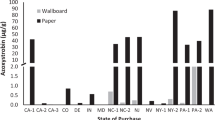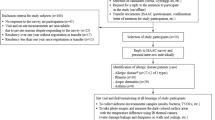Abstract
Mold stain remover (MSR) is used to clean mold and mildew spots from surfaces and contains a variety of chemical substances. In this study, we estimated the inhalation and dermal exposures associated with the use of trigger spray MSRs, and performed screening-level risk assessments for the use of this type of product in Korea. Inhalation and dermal exposures were estimated using exposure algorithms based on exposure factors obtained from a nationwide survey of 10,000 participants and chemical analyses of the four most popular trigger spray MSRs. The hazard quotients (HQs) for noncancer risk and excess cancer risk (ECR) were calculated for each chemical. The mean inhalation exposure estimates for formaldehyde, benzene, chloroform, and carbon tetrachloride were 6.9 × 10−7, 1.7 × 10−7, 5.4 × 10−6, and 2.7 × 10−5 mg/kg/day, respectively. Dermal exposures of the chemicals were 5.7–6.5 times higher than inhalation exposures. The HQs for total exposure were all below 1, which indicated little noncancer risk from the use of MSRs. The safe ECR value of 1 × 10−6, was exceed in one subject for inhalation exposure of benzene and four subjects for dermal exposure of formaldehyde, while 19.8% for dermal exposure of benzene were above this value. Therefore, use of trigger spray MSRs in Korea should require more detailed exposure and risk assessment, especially for benzene.
This is a preview of subscription content, access via your institution
Access options
Subscribe to this journal
Receive 6 print issues and online access
$259.00 per year
only $43.17 per issue
Buy this article
- Purchase on Springer Link
- Instant access to full article PDF
Prices may be subject to local taxes which are calculated during checkout
Similar content being viewed by others
References
Deville, L. The holistic gut prescription: create your own personal path to optimal digestive wellness. New York, USA: Morgan James Publishing; 2018.
The suppers programs, Home cleaning and personal care products guide. https://www.thesuppersprograms.org/content/home-cleaning-and-personal-care-products-guide. Accessed Dec 2018.
Choi Y. Questions and answers about the humidifier disinfectant disaster as of February 2017. Korean J Environ Health. 2017;43:1–22.
Gummin DD, Mowry JB, Spyker DA, Brooks DE, Fraser MO, Banner W. Annual report of the american association of poison control centers’ national poison data system (NPDS): 34th Annual report. Clin Toxicol (Phila). 2016;2017:1–181.
Medina-Ramon M, Zock JP, Kogevinas M, Sunyer J, Anto JM. Asthma symptoms in women employed in domestic cleaning: a community based study. Thorax. 2003;58:950–4.
Karjalainen A, Martikainen R, Karjalainen J, Klaukka T, Kurppa K. Excess incidence of asthma among Finnish cleaners employed in different industries. Eur Respir J. 2002;19:90–5.
Rosenman KD, Reilly MJ, Schill DP, Valiante D, Flattery J, Harrison R, et al. Cleaning products and work-related asthma. J Occup Environ Med. 2003;45:556–63.
Zock JP, Plana E, Jarvis D, Anto JM, Kromhout H, Kennedy SM, et al. The use of household cleaning sprays and adult asthma: an international longitudinal study. Am J Respir Critic Care Med. 2007;176:735–41.
Le Moual N, Varraso R, Siroux V, Dumas O, Nadif R, Pin I, et al. Domestic use of cleaning sprays and asthma activity in females. Eur Respirat J. 2012;40:1381–9.
Matulonga B, Rava M, Siroux V, Bernard A, Dumas O, Pin I, et al. Women using bleach for home cleaning are at increased risk of non-allergic asthma. Respirat Med. 2016;117:264–71.
Park JY, Lim M, Yang W, Lee K. Exposure factors for cleaning, automotive care, and surface protection products for exposure assessments. Food Chem Toxicol. 2017;99:128–34.
Lim HH, Shin HS. Measurement of aldehydes in replacement liquids of electronic cigarettes by headspace gas chromatography-mass spectrometry. Bull Korean Chem Soc. 2013;34:2691–6.
Lim HH, Shin HS. Identification and quantification of phthalates, PAHs, amines, phenols, and metals in tattoo. Bull Korean Chem Society. 2015;36:2039–50.
NIER. Enforcement rule of the act on registration, evaluation, etc. of chemicals. http://law.go.kr/admRulSc.do?tabMenuId=tab107&query=%EC%9C%84%ED%95%B4%EC%9A%B0%EB%A0%A4%EC%A0%9C%ED%92%88#AJAX. Accessed Dec 2018.
NITE. Guidance on a consumer product risk assessment for GHS labelling. Tokyo, Japan: Japan National Institute of Technology and Evaluation Chemical Management Center; 2008. https://www.nite.go.jp/en/chem/risk/ghs_consumer_product.html. Accessed Dec 2018.
ECETOC. Addendum to ECETOC targeted risk assessment report no. 93. Brussels, Belgium: European Centre for Ecotoxicology and Toxicology of Chemicals; 2009. http://www.ecetoc.org/publication/tr-107-addendum-to-ecetoc-targeted-risk-assessment-technical-report-no-93/. Accessed Dec 2018.
Jang JY, Jo SN, Kim SY, Kim SJ, Cheong HK. Korean exposure factors handbook. Seoul, Korea: Korea Ministry of Environment; 2007. http://library.me.go.kr/search/DetailView.ax?sid=1&cid=175874. Accessed Dec 2018.
IARC. Monographs on the evaluation of carcinogenic risks to human volume 100F chemical agents and related occupations. Lyon, France: International Agency for Research on Cancer Lyon; 2012. http://monographs.iarc.fr/ENG/Monographs/vol100F/index.php. Accessed Dec 2018.
US EPA. Risk assessment guidance for superfund volume I human health evaluation manual (Part A). EPA/540/1-89/002. 1989. https://www.epa.gov/sites/production/files/2015-09/documents/rags_a.pdf. Accessed Mar 2019.
US EPA. Supplemental guidance to RAGS: region 4 bulletins, human health risk assessment bulletins. EPA region 4, originally published 1995, Website version last updated May 2000. https://semspub.epa.gov/work/04/10839183.pdf. Accessed Mar 2019.
US EPA. Framework for cumulative risk assessment. Washington, DC, U.S.: U.S. Environmental Protection Agency; 2003. https://www.epa.gov/risk/framework-cumulative-risk-assessment. Accessed Dec 2018.
De Bruin YB, Hakkinen P, Lahaniatis M, Papameletiou D, Pozo CD, Reina V, et al. Risk management measures for chemicals in consumer products: documentation, assessment, and communication across the supply chain. J Expos Sci Environ Epidemiol. 2007;17:S55–66.
RAIS. RAIS toxicity values and chemical parameters. https://rais.ornl.gov/cgi-bin/tools/TOX_search. Accessed Dec 2018
OEHHA. CalEcotox database. 2016. https://oehha.ca.gov/ecotoxicology/general-info/calecotox-database. Accessed Dec 2018.
Acknowledgements
This study is supported by Korea Ministry of Environment as “The Environmental Health Action Program” (#2015001940002).
Author information
Authors and Affiliations
Corresponding author
Ethics declarations
Conflict of interest
The authors declare that they have no conflict of interest.
Additional information
Publisher’s note: Springer Nature remains neutral with regard to jurisdictional claims in published maps and institutional affiliations.
Rights and permissions
About this article
Cite this article
Park, J., Lim, M., Lee, K. et al. Consumer exposure and risk assessment to selected chemicals of mold stain remover use in Korea. J Expo Sci Environ Epidemiol 30, 888–897 (2020). https://doi.org/10.1038/s41370-019-0155-0
Received:
Revised:
Accepted:
Published:
Issue Date:
DOI: https://doi.org/10.1038/s41370-019-0155-0



